Get to know more: AudioCodes multimedia gateway
Good day.
In this article, we will begin the session of several online lectures and articles on a separate line of AudioCodes equipment - universal multimedia gateways, which are positioned for individuals and small businesses. This is the very segment called SOHO. This article will provide an overview and information about the line of devices, the history of its development and a brief description of the functionality. We will talk about the universal CPE AudioCodes MediaPack 26x series (MP26x).
The evolution of the development of this line has more than 8 years. It all started with a series of MP20x devices, which were a simple ATA (Analog Telephone Adapter) with a simple built-in router. There were several models, most of them are no longer available. Nevertheless, still produced and sold in large volumes of devices MP201, MP202, MP204 with 1, 2 and 4 ports FXS, respectively.
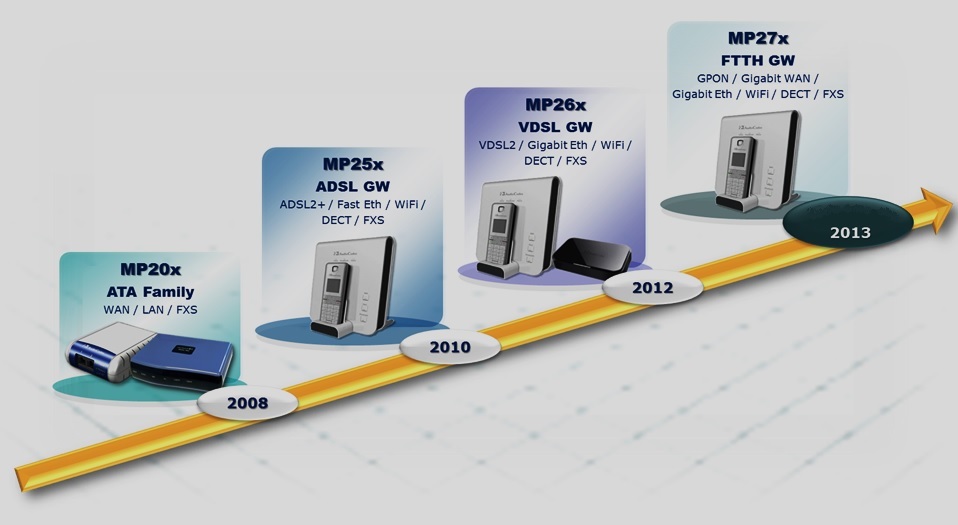
')
On the basis of these devices, in 2010, an updated CPE line - MP252 was created, which was subsequently smoothly and imperceptibly replaced with MP26x. Currently, the MP26x line of devices is the master device and CPE in the line for connecting subscribers from among individuals and is positioned mainly for the operator market. The MP264 equipment is already being sold through regular retail chains.
MediaCack ™ 26x, 272 series devices from AudioCodes are an advanced multi-functional, multimedia home or office gateway for multi-service networks. It supports connection to Ethernet and broadband access networks. The gateway has a built-in modem with ADSL / ADSL2 + / VDSL support, two types of wireless networks are supported - WiFi and DECT. DECT pluggable handsets (up to 5 handsets) support high-quality HD voice over IP (High Definition VoIP); in addition, you can use a battery that will provide the gateway for 3-4 hours when power is lost. The presence of USB ports provides additional benefits for home and office use. The MP-26x, MP-272 devices are a true all-in-one device for working in the Triple Play multi-service network or in a small office.
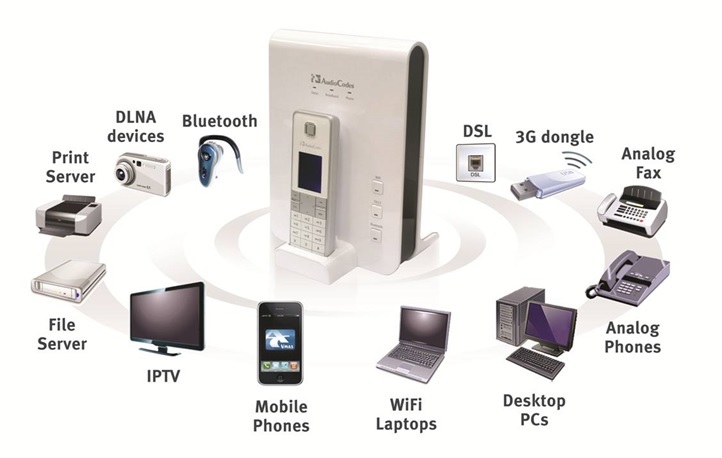
Comparative characteristics of existing models will be produced by several parameters - WAN interfaces, LAN interfaces, their speed, availability of built-in Wi-Fi, DECT and other voice functions.
Let's start with a description of the interfaces. The back panel of the device is shown in the following figure:
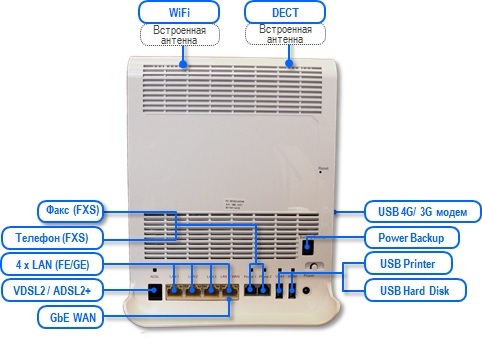
Any device modification contains several essential components:
• 4 LAN ports - allow you to connect all kinds of IP devices, such as set-top boxes, desktops, or various other devices that require an Ethernet connection.
• 4th LAN port works in a combined mode - either LAN or WAN Ethernet, depending on the configuration
• Built-in WiFi access point
• 2 or 3 USB ports - create file or print servers, connect 3G / 4G modems
• 2 FXS ports - for connecting any analog phones or fax machines
• ADSL / VSDL port (built-in ADSL / ADSL2 + / VDSL modem)
Extended models additionally have the following available:
• Built-in DECT base (support for up to 5 handsets)
• Bluetooth support for synchronization of mobile phone address books and built-in DECT database
Model MP272 does not have a built-in ADSL / ADSL2 + / VDSL modem, but instead a dedicated WAN GE port is available.
The total comparison table in terms of interfaces looks like this:
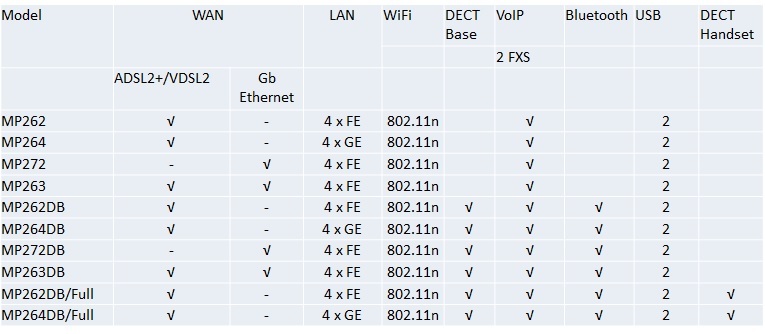
There are also kits where one DECT tube is already included. In this regard, it should be noted that third-party DECT tubes are also supported, but these tubes must support GAP. Otherwise, it will not be possible to register such a handset on the DECT base MP26x / 272.
The functionality of the devices is common to all models. We single out the main points, but not all.
WAN access
• ADSL support: ADSL (ITU-TG.992.1, AnnexA, B), ADSL2 (ITU-TG.992.3 Annex A, B, I, J, L, M), ADSL2 + (ITU-TG.992.5 AnnexA, B, I , J, M), Multiple VC / PPP connections, PVC Scanning
• VDLS support - VDSL2 30a profile, support for VDSL vectoring (G.993.5)
• Support ETH WAN - 10/100 / 1000Mbps Ethernet ports
• 3G / 4G support — all modern connection types, RAS (OPTION driver), NCM (CDC-NCM driver), as well as previous versions of these drivers (depending on the modem)
• Dual WAN - support simultaneously two types of connection (xDSL + LTE, Ethernet + LTE) with traffic balancing
Data Transmission Protocols and Security
• IPv4, PPPoE, PPPoA, PPTP, L2TP, DNS proxy, Dynamic DNS, DHCP Client - Server and Proxy, IP Multicast (IGMP proxy, snooping), NAT - RFC3022, Application Layer Gateway (ALG), Port Triggering, UPnP auto- configuration and port-forwarding (IGD)
• IEEE 802.1p / Q (QoS & VLAN Tagging), ToS / Diffserv, QoS Traffic prioritization and shaping
• SPI Firewall, URL filtering, advanced access control, Denial of Service attack warning, support for encrypted configuration files, Web Authentication, HTTPS provisioning, IPSec
• SIP Security: SIP over TLS support (SIPS)
Wireless LAN support
• Integrated 802.11b / g / n 2x2 WiFi Access Point, Multiple SSID support, up to 300Mbps
• 802.1x authentication, WPA, WPA2, WPA / WEP mixed mode, TKIP Encryption, MAC Filtering, WPS, Web authentication
• Support for various SSIDs for WiFi networks (up to 4 SSIDs)
Voice functionality
• Signaling Protocol - SIP over TCP / UDP - RFC 3261
• Full compatibility with all leading SIP servers and softswitches
• Media traffic processing
- support G.711μ / a-law, G.729A / B, G.723.1, G.722 (for HD VoIP), G722.2 (WB-AMR),
- Analog Signaling Caller ID (Bellcore, ETSI, DTMF),
- MWI DTMF detection and generation, in-band and out-of-band
- generation of customized tones
- T.38 Fax Relay, VBD (Voice Band Data), Bypass
• DECT GAP and CAT-iq 2.0 support on DECT models (MP-2xx-DB)
• DECT upgrade support for compatibility with future versions of CAT-iq
• Flexible configuration and custom SIP settings for DECT handsets
• Built-in auto attendant functionality on the main line to support small offices
Micro PBX
• Support for internal numbers, 5 DECT subscribers, 2 FXS subscribers
• Services: Call Waiting, Call Hold, Call Transfer, Call Forward, Hot Line, 3-Way Conference with Local Mixing, Hunt Group, Do Not Disturb, Flexible Dialing Plan,
• Ability to connect up to 7 simultaneous SIP lines with independent SIP connection parameters (login, password)
• Ability to handle up to 4 simultaneous calls
• Independent switching of internal calls between all subscribers connected to the gateway (intercom)
More detailed information about the line and functionality can be found in a brief description in Russian, which lies here . I also recommend using a special section of our official website: www.audiocodes.com/mp26x
We should also mention the quality of the telephone connection when using the MP26x. Here it is important to say about two aspects. First, it is the ability to use a wide range of codecs, including the AMR streamer codec. This codec is supported on the device and its use provides an undeniable advantage in quality. Secondly, the functionality of the device includes the ability to use the innovative method of ABE (Artificial Bandwidth Extension) - the development of AudioCodes. This feature of the equipment consists in the reconstruction of a broadband voice signal from a narrowband (using mathematical methods, the band of the voice signal is expanded).

It improves speech sensitivity. The subscriber hears voice in HD quality even when making calls to a standard analog line. Therefore, not only the DECT subscriber, but also the FXS subscriber enjoys higher speech quality.
Now let's talk a little about the capabilities of devices in terms of control and diagnostics. Almost all current management capabilities are supported:
1. Built-in Russified web server for configuration and management. This is the most accessible and most common method of controlling and configuring devices.
2. Supports TR-069, TR-104, TR-111 protocols. For example, you can use the free OpenACS as an ACS server for small projects.
3. Support for auto-configuration modes using DHCP - options 66, 67
4. Ability to configure via the command line. This is not always convenient, and applies more to those users who have sufficient skills and knowledge of such management methods.
5. Using configuration files. Moreover, we note that the configuration file is text (however, passwords are stored in it in encrypted form). In addition, the config file can be encrypted and downloaded to the device in an encrypted form. CPE decrypts this file by itself.
6. Support of special functionality for remote provisioning in case of impossibility of access to the device using mechanisms using the HTTP protocol (web, TR-69, etc.). This is more relevant to the topic of mass provisioning of devices in cases where the CPE is located deep in the user network behind NAT or across multiple NATs and when it cannot be managed through the web interface.
As for the diagnosis and troubleshooting, we will highlight the following main points:
1. Advanced tracing and diagnosing capabilities - built-in tcpdump, syslog and packet recording (information directly from the DSP processor)
2. Built-in BroadSoft PacketSmart agent for voice quality control and QoE. This mechanism applies to those operators and their subscribers who use PacketSmart solutions.
3. Support for LST (Local Support and Troubleshooting) functionality - automatic troubleshooting and user notification (interception of web requests and voice notification when trying to make a call) - Russified. This functionality allows you to inform the user about the most common problems. For example, to inform about the disconnected cable or about the lack of SIP registration on the proxy server. It becomes immediately clear where and with which primary information to look for connection problems.
In one of the following articles we will describe in more detail how to use the mechanisms of diagnostics and trashling.
Finally, we say that in the Russian Federation there are many examples of projects where one or another model from this CPE line is used. The number of connected devices on the networks of various telecom operators, both federal and regional, amounts to tens of thousands. However, separately I would like to mention one of these projects. It was launched into commercial operation throughout Russia in May 2015 together with Megafon. One of the devices that is used when connecting to the Express Office service from Megaphone is MP272D. And here you can read a brief description and positioning of the device, as Megafon sees it.
The PRO Express office is a slightly modified MP272DB model, with customized firmware and without Bluetooth. The device is branded for Megaphone and has a special name - Megafon R2. Here is the whole kit and device.
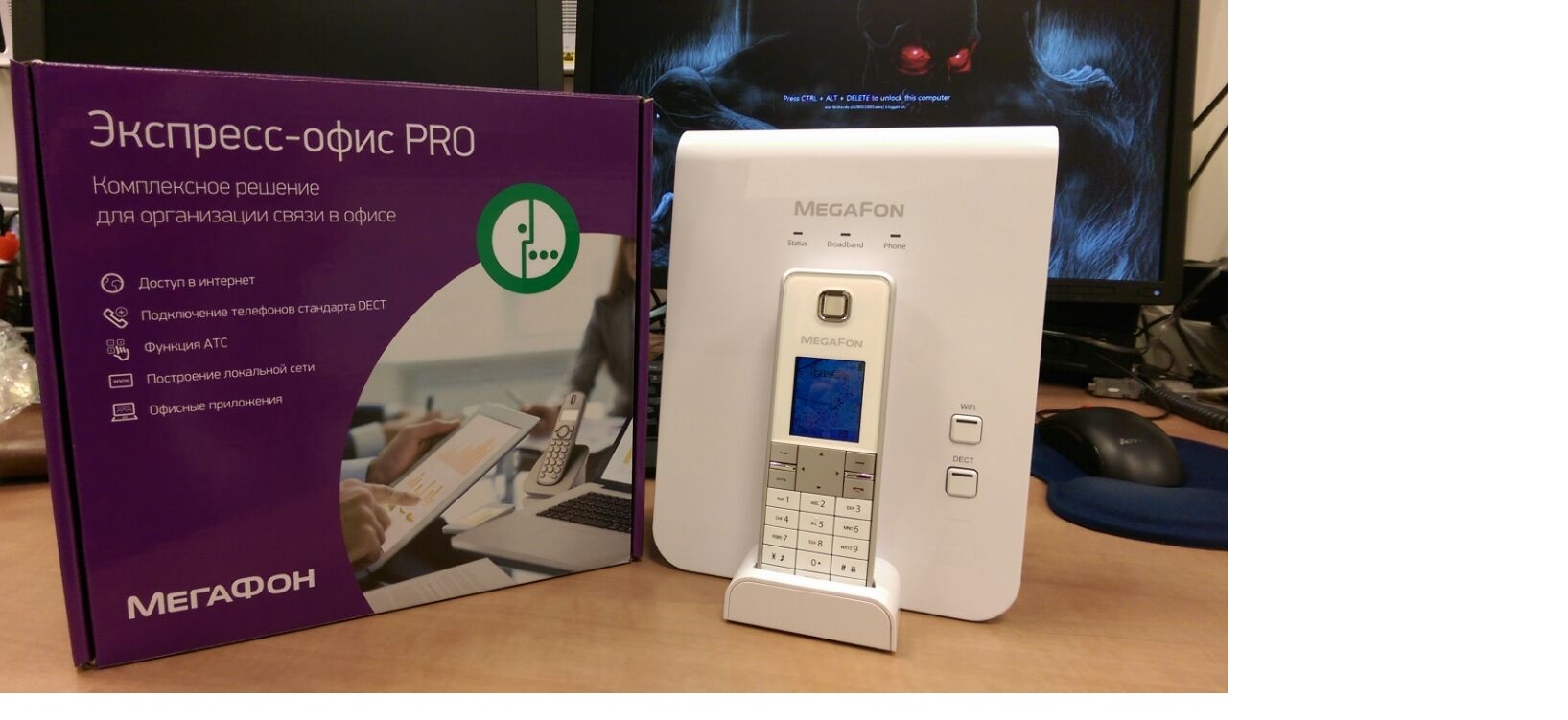

The kit includes 4G modem from Megaphone. And being connected to the USB port, it acts as the main or auxiliary (along with the WAN ETH) uplink. Using 4G makes it possible to deploy a fully wireless small office. Here is a short video about the product features:
We wish you successful connections. Enjoy excellent call quality when using MP26x devices!
In this article, we will begin the session of several online lectures and articles on a separate line of AudioCodes equipment - universal multimedia gateways, which are positioned for individuals and small businesses. This is the very segment called SOHO. This article will provide an overview and information about the line of devices, the history of its development and a brief description of the functionality. We will talk about the universal CPE AudioCodes MediaPack 26x series (MP26x).
The evolution of the development of this line has more than 8 years. It all started with a series of MP20x devices, which were a simple ATA (Analog Telephone Adapter) with a simple built-in router. There were several models, most of them are no longer available. Nevertheless, still produced and sold in large volumes of devices MP201, MP202, MP204 with 1, 2 and 4 ports FXS, respectively.

')
On the basis of these devices, in 2010, an updated CPE line - MP252 was created, which was subsequently smoothly and imperceptibly replaced with MP26x. Currently, the MP26x line of devices is the master device and CPE in the line for connecting subscribers from among individuals and is positioned mainly for the operator market. The MP264 equipment is already being sold through regular retail chains.
MediaCack ™ 26x, 272 series devices from AudioCodes are an advanced multi-functional, multimedia home or office gateway for multi-service networks. It supports connection to Ethernet and broadband access networks. The gateway has a built-in modem with ADSL / ADSL2 + / VDSL support, two types of wireless networks are supported - WiFi and DECT. DECT pluggable handsets (up to 5 handsets) support high-quality HD voice over IP (High Definition VoIP); in addition, you can use a battery that will provide the gateway for 3-4 hours when power is lost. The presence of USB ports provides additional benefits for home and office use. The MP-26x, MP-272 devices are a true all-in-one device for working in the Triple Play multi-service network or in a small office.

Comparative characteristics of existing models will be produced by several parameters - WAN interfaces, LAN interfaces, their speed, availability of built-in Wi-Fi, DECT and other voice functions.
Let's start with a description of the interfaces. The back panel of the device is shown in the following figure:

Any device modification contains several essential components:
• 4 LAN ports - allow you to connect all kinds of IP devices, such as set-top boxes, desktops, or various other devices that require an Ethernet connection.
• 4th LAN port works in a combined mode - either LAN or WAN Ethernet, depending on the configuration
• Built-in WiFi access point
• 2 or 3 USB ports - create file or print servers, connect 3G / 4G modems
• 2 FXS ports - for connecting any analog phones or fax machines
• ADSL / VSDL port (built-in ADSL / ADSL2 + / VDSL modem)
Extended models additionally have the following available:
• Built-in DECT base (support for up to 5 handsets)
• Bluetooth support for synchronization of mobile phone address books and built-in DECT database
Model MP272 does not have a built-in ADSL / ADSL2 + / VDSL modem, but instead a dedicated WAN GE port is available.
The total comparison table in terms of interfaces looks like this:

There are also kits where one DECT tube is already included. In this regard, it should be noted that third-party DECT tubes are also supported, but these tubes must support GAP. Otherwise, it will not be possible to register such a handset on the DECT base MP26x / 272.
The functionality of the devices is common to all models. We single out the main points, but not all.
WAN access
• ADSL support: ADSL (ITU-TG.992.1, AnnexA, B), ADSL2 (ITU-TG.992.3 Annex A, B, I, J, L, M), ADSL2 + (ITU-TG.992.5 AnnexA, B, I , J, M), Multiple VC / PPP connections, PVC Scanning
• VDLS support - VDSL2 30a profile, support for VDSL vectoring (G.993.5)
• Support ETH WAN - 10/100 / 1000Mbps Ethernet ports
• 3G / 4G support — all modern connection types, RAS (OPTION driver), NCM (CDC-NCM driver), as well as previous versions of these drivers (depending on the modem)
• Dual WAN - support simultaneously two types of connection (xDSL + LTE, Ethernet + LTE) with traffic balancing
Data Transmission Protocols and Security
• IPv4, PPPoE, PPPoA, PPTP, L2TP, DNS proxy, Dynamic DNS, DHCP Client - Server and Proxy, IP Multicast (IGMP proxy, snooping), NAT - RFC3022, Application Layer Gateway (ALG), Port Triggering, UPnP auto- configuration and port-forwarding (IGD)
• IEEE 802.1p / Q (QoS & VLAN Tagging), ToS / Diffserv, QoS Traffic prioritization and shaping
• SPI Firewall, URL filtering, advanced access control, Denial of Service attack warning, support for encrypted configuration files, Web Authentication, HTTPS provisioning, IPSec
• SIP Security: SIP over TLS support (SIPS)
Wireless LAN support
• Integrated 802.11b / g / n 2x2 WiFi Access Point, Multiple SSID support, up to 300Mbps
• 802.1x authentication, WPA, WPA2, WPA / WEP mixed mode, TKIP Encryption, MAC Filtering, WPS, Web authentication
• Support for various SSIDs for WiFi networks (up to 4 SSIDs)
Voice functionality
• Signaling Protocol - SIP over TCP / UDP - RFC 3261
• Full compatibility with all leading SIP servers and softswitches
• Media traffic processing
- support G.711μ / a-law, G.729A / B, G.723.1, G.722 (for HD VoIP), G722.2 (WB-AMR),
- Analog Signaling Caller ID (Bellcore, ETSI, DTMF),
- MWI DTMF detection and generation, in-band and out-of-band
- generation of customized tones
- T.38 Fax Relay, VBD (Voice Band Data), Bypass
• DECT GAP and CAT-iq 2.0 support on DECT models (MP-2xx-DB)
• DECT upgrade support for compatibility with future versions of CAT-iq
• Flexible configuration and custom SIP settings for DECT handsets
• Built-in auto attendant functionality on the main line to support small offices
Micro PBX
• Support for internal numbers, 5 DECT subscribers, 2 FXS subscribers
• Services: Call Waiting, Call Hold, Call Transfer, Call Forward, Hot Line, 3-Way Conference with Local Mixing, Hunt Group, Do Not Disturb, Flexible Dialing Plan,
• Ability to connect up to 7 simultaneous SIP lines with independent SIP connection parameters (login, password)
• Ability to handle up to 4 simultaneous calls
• Independent switching of internal calls between all subscribers connected to the gateway (intercom)
More detailed information about the line and functionality can be found in a brief description in Russian, which lies here . I also recommend using a special section of our official website: www.audiocodes.com/mp26x
We should also mention the quality of the telephone connection when using the MP26x. Here it is important to say about two aspects. First, it is the ability to use a wide range of codecs, including the AMR streamer codec. This codec is supported on the device and its use provides an undeniable advantage in quality. Secondly, the functionality of the device includes the ability to use the innovative method of ABE (Artificial Bandwidth Extension) - the development of AudioCodes. This feature of the equipment consists in the reconstruction of a broadband voice signal from a narrowband (using mathematical methods, the band of the voice signal is expanded).

It improves speech sensitivity. The subscriber hears voice in HD quality even when making calls to a standard analog line. Therefore, not only the DECT subscriber, but also the FXS subscriber enjoys higher speech quality.
Now let's talk a little about the capabilities of devices in terms of control and diagnostics. Almost all current management capabilities are supported:
1. Built-in Russified web server for configuration and management. This is the most accessible and most common method of controlling and configuring devices.
2. Supports TR-069, TR-104, TR-111 protocols. For example, you can use the free OpenACS as an ACS server for small projects.
3. Support for auto-configuration modes using DHCP - options 66, 67
4. Ability to configure via the command line. This is not always convenient, and applies more to those users who have sufficient skills and knowledge of such management methods.
5. Using configuration files. Moreover, we note that the configuration file is text (however, passwords are stored in it in encrypted form). In addition, the config file can be encrypted and downloaded to the device in an encrypted form. CPE decrypts this file by itself.
6. Support of special functionality for remote provisioning in case of impossibility of access to the device using mechanisms using the HTTP protocol (web, TR-69, etc.). This is more relevant to the topic of mass provisioning of devices in cases where the CPE is located deep in the user network behind NAT or across multiple NATs and when it cannot be managed through the web interface.
As for the diagnosis and troubleshooting, we will highlight the following main points:
1. Advanced tracing and diagnosing capabilities - built-in tcpdump, syslog and packet recording (information directly from the DSP processor)
2. Built-in BroadSoft PacketSmart agent for voice quality control and QoE. This mechanism applies to those operators and their subscribers who use PacketSmart solutions.
3. Support for LST (Local Support and Troubleshooting) functionality - automatic troubleshooting and user notification (interception of web requests and voice notification when trying to make a call) - Russified. This functionality allows you to inform the user about the most common problems. For example, to inform about the disconnected cable or about the lack of SIP registration on the proxy server. It becomes immediately clear where and with which primary information to look for connection problems.
In one of the following articles we will describe in more detail how to use the mechanisms of diagnostics and trashling.
Finally, we say that in the Russian Federation there are many examples of projects where one or another model from this CPE line is used. The number of connected devices on the networks of various telecom operators, both federal and regional, amounts to tens of thousands. However, separately I would like to mention one of these projects. It was launched into commercial operation throughout Russia in May 2015 together with Megafon. One of the devices that is used when connecting to the Express Office service from Megaphone is MP272D. And here you can read a brief description and positioning of the device, as Megafon sees it.
The PRO Express office is a slightly modified MP272DB model, with customized firmware and without Bluetooth. The device is branded for Megaphone and has a special name - Megafon R2. Here is the whole kit and device.


The kit includes 4G modem from Megaphone. And being connected to the USB port, it acts as the main or auxiliary (along with the WAN ETH) uplink. Using 4G makes it possible to deploy a fully wireless small office. Here is a short video about the product features:
We wish you successful connections. Enjoy excellent call quality when using MP26x devices!
Source: https://habr.com/ru/post/272913/
All Articles